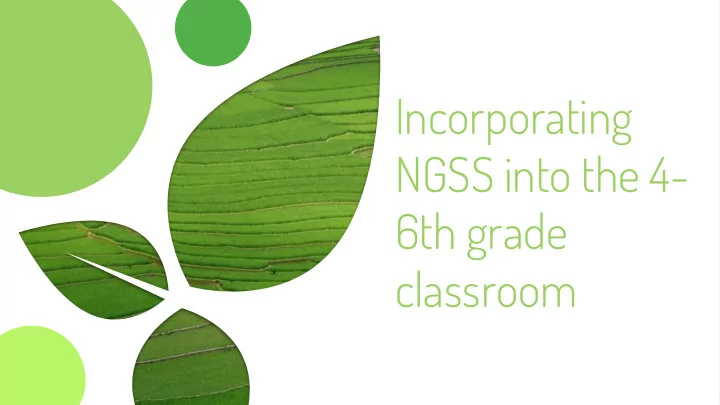

Incorporating NGSS into the 4- 6th grade classroom
Guiding Question How can I incorporate the NGSS into my classroom using existing materials? 2
Hello! We are Ian Kastelic from San Mateo-Foster City, CA and Alicia Payton-Miyazaki from Menlo Park, CA, 3
Resources ⊷ Ideas for Modifying lessons ⊷ How to incorporate the SEPs ⊷ Link to Stanford SCALE SNAP ⊷ CCC question stems ⊷ CER Sample Template 4
Stages of Implementation
https://www.sdcoe.net/lls/ccr/Pages/sciencepd.aspx Pleas ase e enter er your r level vel now! 6
Stage 2 and 3 1. Activity before content (Lab before “ you blab) 2. Integration of SEPs* and CCCs a. Modeling b. Argumentation from evidence 3. Assessment *Achieve and the NGSS suggested these 2 as THE place to start. “If you do nothing else, do these!” 7
Activity before content (Lab before you blab) Example: What questions do you have about Activity Before Content 8
Integration of SEPs: Modeling Image from SNAP Stanford Assessment Project 9
Different Types of Models 10
Different Types of Models 11
Activities that support modelling Developing and Using Models 1. Have students create a model of a system that they revisit, refine, and edit throughout the unit. 2. Compare and contrast different student created models for the same phenomenon. 3. Identify and explain weaknesses or limitations in published (curriculum, web, or even student etc) models. Identify and explain strengths . 4. Explain how a student-created model relates to a real world situation. 5. Use a model to predict changes in a real world situation. 12
Argumentation from Evidence 13
Activities that support Argumentation Engaging in Argument from Evidence 1. Present students with numerous pieces of data about a topic. Some contradictory, or vague. As a class have students evaluate which pieces of data are most relevant and accurate and why. (Page Keeley prompts) 1. Have students engage in a class debate after gathering evidence from experiments they designed about phenomenon, debating what their data proves 1. As a class create a rubric for a successful design to solve a problem. Have students use design thinking to create a solution, share design solutions and have the class write or orally argue about how well different designs meet the rubric using evidence. 14
Activities that support Argumentation Engaging in Argument from Evidence 4. Use CER - Claim-Evidence-Reasoning 5. Host a scientific debate about a current scientific situation in the news. (Should vaccines be required for all students to attend all schools? Is the money spent on the Mars rovers better used elsewhere?) 6. Make a padlet that is divided into Pro and Con for a topic and allow students to post 15
CER Template and Information 16
Assessment Stanford SCALE project 5.LS.2-1 You can insert graphs from Google Sheets 17
18
19
20
Cross Cutting Concepts
Chess experts and novices players were shown pieces randomly arranged on a chess board… Image credit: Aranda, J. (2006, August 29). Fun with representations III – Hidden in plain sight. Retrieved May 23, 2015, from https://catenary.wordpress.com/2006/08/29/fun-with-representations-iii-hidden-in-plain- National Research Council. How People Learn: Brain, Mind, Experience, and School: sight/ Expanded Edition. Washington, DC: The National Academies Press, 2000. doi:10.17226/9853.
Experts grouped pieces together Novices only remembered based on the strategic moves that individual pieces . the pieces could make in a game. Rooks Pawns Knights Queens Bishops Kings Image credit: Aranda, J. (2006, August 29). Fun with representations III – Hidden in plain sight. Retrieved May 23, 2015, from https://catenary.wordpress.com/2006/08/29/fun-with-representations-iii-hidden-in-plain- National Research Council. How People Learn: Brain, Mind, Experience, and School: sight/ California Academy of Sciences Expanded Edition. Washington, DC: The National Academies Press, 2000. doi:10.17226/9853.
One goal of science education is to teach students think more like experts » What if we gave students an expert-like conceptual framework to organize their ideas around? To this From this catenary.wordpress.com California Academy of Sciences
How will the CCCs help students learn science? 1. A conceptual framework helps students make sense of new content and tackle novel problems 1. Allows students to be more flexible and creative with their science and engineering ideas 1. Helps students to develop their ideas over time A Framework for K-12 California Academy of Sciences Education, Project 2061
Structure and Function 1. How does the shape of ______ support its function? 2. Predict how changing the shape would change the functionality. 3. Design a different structure that might be able to perform the same function. 4. Describe how the properties of the materials in this system are important. Samples from the Cross Cutting Concepts Questioning Stems found in Resources 26
Stage 4: Integration 27
Stage 2 and 3 1. Activity before content (Lab before “ you blab) 2. Integration of SEPs and CCCs a. Modeling b. Argumentation from evidence 3. Assessment Achieve and the NGSS suggested these 2 as THE place to start. “If you do nothing else, do these!” 28
Resources https://tinyurl.com/Flinn2019 ⊷ CCC question stems ⊷ How to incorporate the SEPs ⊷ Link to Stanford SCALE SNAP ⊷ Ideas for Modifying lessons ⊷ CER Sample Template 29
Credits Special thanks to all the people who made and released these awesome resources for free: ⊷ Presentation template by SlidesCarnival ⊷ Photographs by Unsplash ⊷ Stanford SCALE SNAP Assessments ⊷ Cal Academy of Science in CA ⊷ NGSS @NSTA ⊷ Craig T Gabler 30
Recommend
More recommend